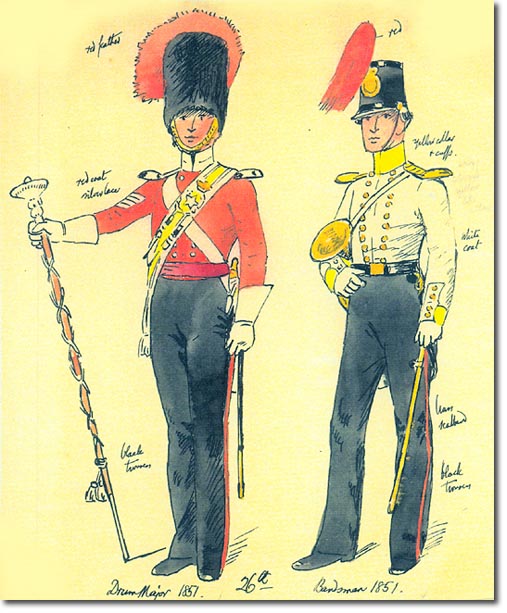|
|

 |
|
There was a distinction between the Corps of Drums and the band which dated back to the middle of the 18th century. The Drums were men taken on the strength of the regiment, required to perform functions other than beat time. Drummers would act as messengers to parlay with the enemy; they would also go into action with the rest of the regiment. Drum-majors were responsible for discipline in the regiment and took charge of floggings. Bandsmen, on the other hand, were employed to play music, not to carry weapons other than an ornamental sword. Although they were used to carry and tend to the wounded in times of war.
The drum-major was the leader of the Corps of Drums and as such followed the dress of the drummers rather than the band. That is why he has a red coat while the bandsman wears white. In 1831 the practice of wearing reverse colours ceased so that drummers and drum-majors of the 26th no longer wore yellow coats faced red. Although the regiment changed from being a silver laced regiment to gold laced in 1830, it was traditional for drum-majors to have silver lace, so this man has a yellow collar with silver lace showing on the front part, and silver shoulder scales, buttons and 4 chevrons on his right arm. The elaborate belt worn over his left shoulder is yellow with silver edges and an embroidered badge with a large silver mullet (star) and gold crown. The tall bearskin cap has a long red plume that curls over the top. The bandsman has a similar shako to that worn by the regiment but the ball tuft at the front is replaced by a falling red horsehair plume. The badge would also be a special band badge. The white coat was the usual form of dress for bands up until the 1870s although from 1856 a white tunic replaced the tailed coat. The facings are yellow and the shoulder scales and buttons are brass. His sword, sheathed in a brass scabbard, is of normal length at this stage; later it became a short decorative item. It is slung from a black leather belt with brass buckle. |
Armed Forces | Art and Culture | Articles | Biographies | Colonies | Discussion | Glossary | Home | Library | Links | Map Room | Sources and Media | Science and Technology | Search | Student Zone | Timelines | TV & Film | Wargames
